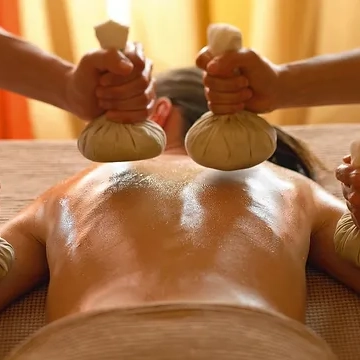In today’s fast-paced world, muscle pain has become a common issue due to sedentary lifestyles, stress, and lack of physical activity. While modern medicine offers painkillers and muscle relaxants, these provide only temporary relief and often come with side effects. Ayurveda, the ancient Indian system of medicine, offers a holistic approach to treating muscle pain through Panchakarma therapy. Panchakarma not only brings down the pain but also detoxifies and rejuvenates the entire body.
Understanding muscle pain in Ayurveda
According to Ayurveda, muscle pain is often linked to an imbalance in the Vata dosha, which governs movement and nervous functions in the body. Excess Vata can lead to dryness, stiffness, and pain in the muscles. Sometimes, an imbalance in Pitta dosha can cause inflammation and burning sensations, while Kapha dosha imbalances may lead to stiffness and heaviness. Panchakarma therapy aims to restore balance to these doshas, providing long-term relief from muscle pain.
Panchakarma is a comprehensive detoxification therapy in Ayurveda that comprises five primary cleansing procedures:
- Vamana (Therapeutic Emesis) – Eliminates toxins through controlled vomiting, mainly used for Kapha disorders.
- Virechana (Purgation Therapy) – Detoxifies the liver and intestines, primarily beneficial for Pitta imbalances.
- Basti (Medicated Enema Therapy) – Best for Vata disorders, as it nourishes and lubricates the intestines and body.
- Nasya (Nasal Administration) – Clears toxins from the head, neck, and nervous system, often helpful for headaches and stress-related tension.
- Raktamokshana (Bloodletting Therapy) – Removes impurities from the blood, particularly for inflammatory conditions.
Panchkarma therapies for muscle pain
- Abhyanga (Ayurvedic Oil Massage)
A full-body warm oil massage with medicated herbal oils like Mahanarayana oil or Dhanwantharam oil helps improve circulation, relax muscles, and reduce pain.
- Swedana (Herbal Steam Therapy)
This therapy involves exposure to herbal steam, which opens up pores, relaxes stiff muscles, and eliminates toxins.
- Kati Basti (Localized Oil Therapy)
A specialized treatment for back and muscle pain, where a pool of warm medicated oil is placed over the affected area. It nourishes deep tissues, relieves pain, and improves mobility.
- Basti (Medicated Enema Therapy)
Since Vata governs the nervous system and movement, Basti is one of the most effective Panchakarma treatments for chronic muscle pain, as it helps lubricate joints, reduce stiffness, and eliminate toxins.
Benefits of Panchakarma for muscle pain
- Long-term relief from muscle pain and stiffness
- Enhanced circulation and oxygenation to the muscles
- Reduced inflammation and detoxification of metabolic wastes
- Increased flexibility and mobility
- Mental relaxation, reducing stress-induced muscle tension
Conclusion
Unlike conventional treatments that offer symptomatic relief, Panchakarma addresses the root cause of pain by balancing the body’s doshas and eliminating toxins. If you suffer from chronic muscle pain, Ayurveda and Panchakarma can offer a natural and effective solution, helping you regain strength, flexibility, and overall well-being. Always consult a qualified Ayurvedic practitioner to personalize the treatment according to your unique body constitution.
Views: 92
